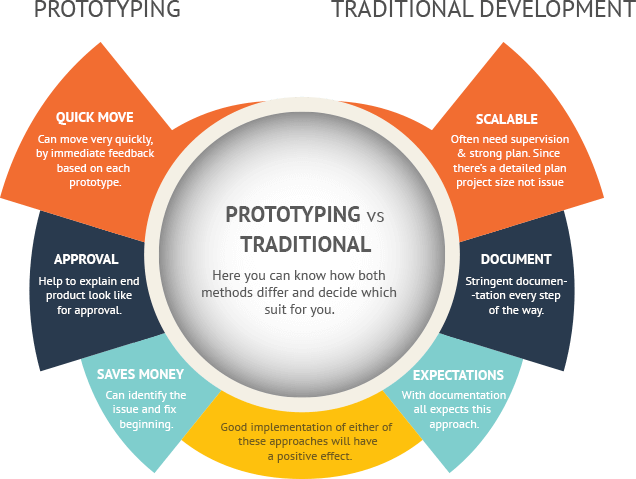Rapid prototyping is a key part of product development, allowing engineers and designers to create physical versions of their ideas quickly. These prototypes are essential for testing and refining product designs before going into full production. Understanding the pros and cons of different rapid prototyping methods is critical to choosing the right one, which will impact the efficiency, cost, and success of the product development process. Whether using additive manufacturing or traditional methods like CNC machining, the right choice will make all the difference between a smooth, cost-effective process and a series of costly iterations.
What Is Rapid Prototyping?
Rapid prototyping (RP) is a process that turns digital CAD designs into physical models using advanced manufacturing techniques like 3D printing, CNC machining, and injection molding. This allows for the rapid creation of prototypes that can be high fidelity (look and feel like the final product) or low fidelity (test-specific components). By enabling fast iteration, rapid prototyping lets designers and engineers test form, fit, and function early in the development cycle so you can make decisions faster and get to market quicker. It allows you to refine and perfect your designs based on accurate testing and feedback.
Rapid Prototyping Methods & Their Pros & Cons
1. 3D Printing (Additive Manufacturing)
3D printing, or additive manufacturing, builds objects layer by layer from digital models. This method works with many materials, including plastics, metals, and ceramics, and is used in Fused Deposition Modelling (FDM), Selective Laser Sintering (SLS), and Stereolithography (SLA). It’s great for complex geometries that are hard to achieve with other methods.
Pros
- Versatility: Works with many materials, production flexibility.
- Complex Geometries: Can make detailed and complex designs that can’t be made otherwise.
- Speed: Quick turnaround for small parts and prototypes.
Cons
- Material limitations: Not all materials can be 3D printed, which limits their use.
- Surface Finish: Post-processing may be needed to get a smooth finish, depending on the 3D printing method.
- Structural Integrity: Parts, especially FDM, may not be strong enough for functional use.
2. CNC Machining
CNC machining is a subtractive process where material is removed from a solid block to make a part. Known for its accuracy, it is often used for metal prototypes and components made from materials like stainless steel. CNC machining is best for high accuracy and smooth surface finishes.
Pros
- Accuracy: Very accurate for high tolerance applications.
- Material: Machines many materials, including metals, plastics, and stainless steel.
Cons
- Waste: Creates a lot of waste as it’s a subtractive process.
- Complexity: Its ability to make internal geometries is limited compared to additive methods.
- Cost: More expensive as you need specialized equipment and skilled operators.
3. Stereolithography (SLA)
Stereolithography (SLA) is a process that uses a laser to solidify liquid resin. Known for its accuracy, SLA produces super-detailed and smooth prototypes. Compatible with many resins, it’s a great option for detailed prototyping.
Pros
- High Definition: Finest details and smoothest surface finish, perfect for intricate prototypes.
- Precision: Great for complex and accurate parts.
- Material Options: There are many resins to choose from.
Cons
- Brittle: Parts can break easily and are not suitable for functional testing.
- Material Cost: Resin materials are more expensive than others.
- Post-Processing: Requires cleaning and curing, adds to lead time.
4. Selective Laser Sintering (SLS)
Selective Laser Sintering (SLS) fuses powdered material into solid form with a laser. It’s great for tough and functional prototypes with complex geometries. Unlike other additive processes, SLS doesn’t require support structures, so it’s ideal for intricate designs.
Pros
- Strong and Functional: Parts are suitable for end use.
- No Support Structures Needed: Complex designs without extra support material.
- Material Options: Compatible with many materials, including nylon and composites.
Cons
- Rough Surface: Parts have a grainy surface that may require post-processing for a smooth finish.
- Expensive: More material and operational cost than other additive processes.
- High Energy Consumption: Process consumes a lot of energy.
5. Injection Molding
Injection molding is where molten plastic or metal is pushed into a mold cavity under pressure. Once cooled it solidifies to form a part. It’s great for mass production as it can produce consistent high quality parts in large quantities. Good for complex geometries and fine details. Used for consumer goods, automotive parts and plastic products.
Pros
- Fast Production: Can produce large quantities of parts quickly.
- Precision and Detail: High precision and detail, good for complex geometries and fine features.
- Material Options: Works with many materials, plastics, metals, composites.
Cons
- High Upfront Costs: Requires big investment in tooling and machinery, not cost effective for low volume production.
- Long Lead Times: Tool design and fabrication takes time before production can start.
- Design Changes: Changing the design of a part after the tool is made can be difficult and expensive.
Comparison Table
Table of comparison with advantages & disadvantage for Each Method
| Method | Key Advantages | Key Disadvantages | Best Suited For |
| 3D Printing | Versatile, fast, complex geometries | Surface finish, structural integrity | Prototyping complex, small parts |
| CNC Machining | Precision, material variety, smooth surfaces | Material waste, cost, limited complexity | High-tolerance, metal prototypes |
| SLA | High resolution, precision, smooth finish | Fragility, material cost, post-processing | Detailed, accurate, visual prototypes |
| SLS | Durability, no support structures, material variety | Surface roughness, energy use, cost | Functional prototypes, end-use parts |
| Injection Molding | High quality, material variety, excellent surface finish | Initial tooling cost, less flexibility than other methods | High-volume production, manufacturability testing |
Rapid Prototyping Use Cases in Industry
In the auto industry Ford uses rapid prototyping to speed up and improve processes. They can create complex parts quickly and cheaply without the need for expensive tooling. In the aerospace industry NASA uses rapid prototyping to test new ideas quickly and cost effectively. For example they used it to make a scale model of their Mars Rover so they could test and refine the design before launch. Companies in the medical and dental industry have used rapid prototyping to create custom prosthetic limbs, dental implants, and even 3D-printed organs. This has led to huge advancements where detail and high biological safety is key.
Industry Expert Views on Rapid Prototyping
Experts say you should match your rapid prototyping method to your project. One view is that by understanding the benefits of each you can tailor your approach so the chosen method addresses both functional and economical requirements.
In case studies companies have shown that combining methods for example using SLA for initial design validation and CNC Machining for final production ready prototypes can speed up the development process. For example this can reduce development cycles by up to 30% so choosing the right method at the right stage of rapid prototyping is key.
Conclusion
Selecting the right rapid prototyping method is key to your product development process. Each method has its pros and cons and should match your project needs. Whether you need high precision and material integrity like CNC Machining or SLS or the flexibility and speed of 3D Printing for quick design iterations the choice can make a big difference to your project timeline and quality.
At Devomech Solutions we understand these complexities and are here to help you navigate through them. With our experience in product design and prototyping we can guide you to select the best rapid prototyping method for your project. Our team is expert in turning your ideas into market ready products so your product not only meets but exceeds industry standards. Get in touch with us today to turn your idea into a product.

